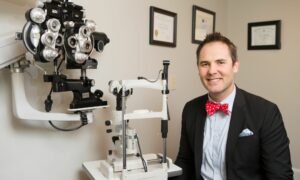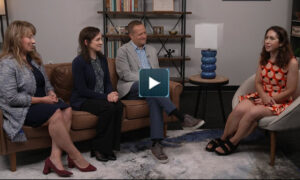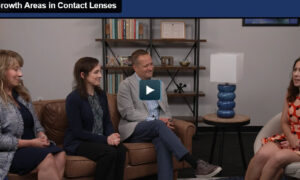By Suzanne LaKamp, OD, FAAO
Sept. 2, 2015
SYNOPSIS
Serve a growing need and build profits with multifocal contact lenses. To succeed, increase your knowledge and be fully equipped and stocked.
ACTION POINTS
RECOGNIZE OPPORTUNITY. Calculate how many patients are over 45, how many are already in CLs & how many can be introduced to CLs for the first time.
EDUCATE PATIENTS. Let patients know of the new, advanced designs and materials, and give them the opportunity to trial multifocal CLs.
GIVE LENS CHOICE. Offer more than just one type of multifocal lens to serve all patients.
With the aging of the population, optometrists have a valuable opportunity both to make many of our patients more satisfied with their vision–and to create a profitable practice builder. I work in an Overland Park, Kan., practice, with three MDs and two ODs. We have a surgically based practice with an older demographic–a prime audience for multifocal contact lenses. Fitting patients in multifocal contact lenses is both good for them, as well as for our practice’s growth, as satisfied patients refer friends and family, and keep returning each year to renew their prescription.
There are new multifocal contact lens designs, available in materials with enhanced comfort features, that can sustain contact lens wear among active mid-life and senior patients,or even renewinterest in contact lens wear with older patients.
As the materials and optics of multifocal contact lenses have improved greatly over the years, this vision correction modality has grown in popularity. Patients new to contact lenses want to know that the technology is the latest advancement in an already proven field. While multifocal contact lenses are not new, patients are unfamiliar with the most recent advancements. Patients rely on the provider to mention multifocal contacts as a possibility, and can leave disappointed if not offered.A patient cannot try something new without the chance. Patients may leave a practice that neglects, or fails, to anticipate their needs.
Another benefit of multifocals: Adaptation to the optics of multifocal contact lenses in the early stages of presbyopia can be of benefit to the patient during the later stages of lens dysfunction and eventual cataract years down the road. Successful multifocal contact lens patients are more likely to become successful multifocal IOL patients when the need arises.
Recognize Your Opportuntiy
I average seeing about 15 contact lens patients a week. The majority of these patients are presbyopic, already wearing or needing to be fit into multifocal contact lenses. While at a previous practice, the average age of my surgical patients was about 70, and the average contact lens patient was 50.
Our practice servesa predominantly presbyopic patient base. Practices all over are also experiencing a very active, aging population wanting to be free of glasses. As the aging portion of the population continues to grow, so will the demand for multifocal contact lenses.
Have the Conversation:
Transitioning from Single-Vision to Multifocal
Happy patients are typically reluctant to change vision correction modality. For the single-vision wearers, however, this is less likely to satisfy the patient’s visual demands as presbyopia progresses.
Some practitioners may keep the patients in single vision, and prescribe monovision, or modified monovision, to help with near vision demands. As the amount of natural lens dysfunction advances, the amount of add must be increased. Anything beyond 1.5 D in single vision quickly becomes intolerable, leads to asthenopia, and diminishes stereopsis.
Patient: “I don’t know if I want to switch from these contacts I’ve been wearing for a while. I really like them.”
Doctor: “I understand your comfort with the contacts you’ve been wearing for years, but I really think you’re going to like the multifocal contact lenses we have available now. Multifocal contact lenses represent the latest in contact lens design technology. You don’t want to wear outdated technology.”
Patient: “Will I really see that much better in them?”
Doctor: “I really think you will. Multifocal contact lenses are designed to provide enhanced visual performance, and allow you to see both near and far, and even can improve your depth perception.”
Build a Loyal Patient Base
There is a growing percentage of the contact lens wearing population that is very active, and experiencing presbyopia. By addressing the presbyopia with multifocal contact lenses, the practice is more likely to retain this segment of patients. Happy contact lens patients are loyal patients. They are more likely to return for annual examinations than the glasses-only patient population. More examinations mean more practice profit. It is advisable for any contact lens wearer to have a back-up pair of spectacles, further increasing the profit per patient.
Great Profit in Fitting Multifocal CLs
There is less profit from selling lenses directly out of the office in materials fees as compared to the profit from fitting fees, examination fees and services. At my previous practice in Georgia, we carried complete fitting sets for all of the major multifocal contact lenses in the entire range of powers available. I found varying degrees of success depending on the brand. I typically picked from among my favorites with massive success, and could likely fit the majority of soft multifocal contact lens patients using only two or three fitting sets.
Any trial lenses given out were immediately re-ordered and re-stocked. Having the exact lens ensured the correct power was immediately available to the patient, therefore increasing fitting success. Lenses that needed to be ordered could sometimes take one to two weeks. It is imperative to eliminate delays, as patients can easily find the lens he or she needs at a competitive practice. Once that patient gets a good fit, the prescription can be released, and the patient is likely to stay with that practice.
Give Patient Options of Different Lenses
One lens type does not fit everyone. By carrying a number of different multifocal lens designs, the many options allow for an increase in successful fits. It is possible for a practitioner to achieve success with more difficult fits by also thinking alternatively and adapting to the needs of the patient. While I typically adhere to manufacturer fitting guidelines with multifocal designs, I have had success with certain modifications for my more challenging cases. For some patients with critical distance demands (frequent nighttime driving), I will use a multifocal contact lens in the near eye, and a single-vision distance lens in the dominant eye.
Educate Patients About Purchasing Progressive Eyeglasses, Too
All contact lens patients are encouraged to have prescription eyeglasses. I always recommend progressive spectacle lenses over a traditional bifocal, unless the patient has had a prior history of intolerance. The patient should know it is vital to have a backup pair ofprogressive lens eyewear, so they can easily can go to a backup pair if they experience discomfort–rather than worsening a potential infection or damaging the cornea.
Choose Best Candidates & Set Expectations
Most important to multifocal contact lens success is determining proper multifocal candidacy. With proper patient selection, it should be uncommon not to fulfill a patient’s expectations. I never tell a patient that he or she will have to sacrifice any range of vision. Myopes, for instance, will need to be educated about the adaptation process differently than hyperopes. Since some myopes are accustomed to using near vision without the aid of reading glasses, a multifocal lens can frustrate the patient as the range of near vision can shift.
In this example, the myope can be reminded that the multifocal lens provides functional clear vision at all distances, rather than crisp vision at a single focal point. For multifocal candidates, I talk at length about the adaptation process of adjusting to multifocal contact lenses. Patient education is key. If a patient feels that he or she is sacrificing vision, I am not properly setting expectations. I will change a fit, or a product, until the patient is satisfied. Presentation is the second most important aspect of multifocal contact lens fits. Patients respond well to enthusiastic, positive providers. Efficiency is also important. While a few follow-up visits with multifocal lenses are standard, a patient will not tolerate many more than that.
Suzanne LaKamp, OD, FAAO, is an associate at Durrie Vision in Overland Park, Kan. To contact: dr.suzanne.lakamp@gmail.com



























